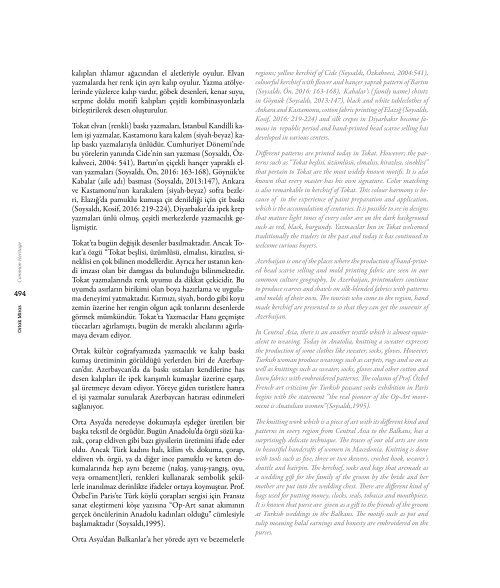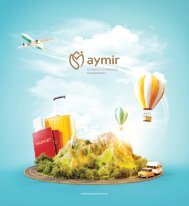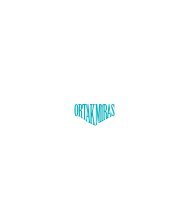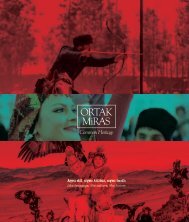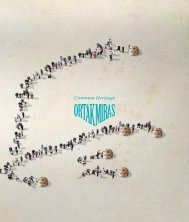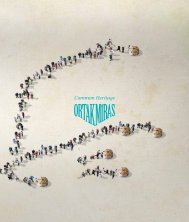You also want an ePaper? Increase the reach of your titles
YUMPU automatically turns print PDFs into web optimized ePapers that Google loves.
Common Heritage<br />
494<br />
Ortak Miras<br />
kalıpları ıhlamur ağacından el aletleriyle oyulur. Elvan<br />
yazmalarda her renk için ayrı kalıp oyulur. Yazma atölyelerinde<br />
yüzlerce kalıp vardır, göbek desenleri, kenar suyu,<br />
serpme doldu motifi kalıpları çeşitli kombinasyonlarla<br />
birleştirilerek desen oluşturulur.<br />
Tokat elvan (renkli) baskı yazmaları, İstanbul Kandilli kalem<br />
işi yazmalar, Kastamonu kara kalem (siyah-beyaz) kalıp<br />
baskı yazmalarıyla ünlüdür. Cumhuriyet Dönemi’nde<br />
bu yörelerin yanında Cide’nin sarı yazması (Soysaldı, Özkahveci,<br />
2004: 541), Bartın’ın çiçekli hançer yapraklı elvan<br />
yazmaları (Soysaldı, Ön, 2016: 163-168), Göynük’te<br />
Kabalar (aile adı) basması (Soysaldı, 2013:147), Ankara<br />
ve Kastamonu’nun karakalem (siyah-beyaz) sofra bezleri,<br />
Elazığ’da pamuklu kumaşa çit denildiği için çit baskı<br />
(Soysaldı, Kosif, 2016: 219-224), Diyarbakır’da ipek krep<br />
yazmaları ünlü olmuş, çeşitli merkezlerde yazmacılık gelişmiştir.<br />
Tokat’ta bugün değişik desenler basılmaktadır. Ancak Tokat’a<br />
özgü “Tokat beşlisi, üzümlüsü, elmalısı, kirazlısı, sineklisi<br />
en çok bilinen modellerdir. Ayrıca her ustanın kendi<br />
imzası olan bir damgası da bulunduğu bilinmektedir.<br />
Tokat yazmalarında renk uyumu da dikkat çekicidir. Bu<br />
uyumda asırların birikimi olan boya hazırlama ve uygulama<br />
deneyimi yatmaktadır. Kırmızı, siyah, bordo gibi koyu<br />
zemin üzerine her rengin olgun açık tonlarını desenlerde<br />
görmek mümkündür. Tokat’ta Yazmacılar Hanı geçmişte<br />
tüccarları ağırlamıştı, bugün de meraklı alıcılarını ağırlamaya<br />
devam ediyor.<br />
Ortak kültür coğrafyamızda yazmacılık ve kalıp baskı<br />
kumaş üretiminin görüldüğü yerlerden biri de Azerbaycan’dır.<br />
Azerbaycan’da da baskı ustaları kendilerine has<br />
desen kalıpları ile ipek karışımlı kumaşlar üzerine eşarp,<br />
şal üretmeye devam ediyor. Yöreye giden turistlere hatıra<br />
el işi yazmalar sunularak Azerbaycan hatırası edinmeleri<br />
sağlanıyor.<br />
Orta Asya’da neredeyse dokumayla eşdeğer üretilen bir<br />
başka tekstil de örgüdür. Bugün Anadolu’da örgü sözü kazak,<br />
çorap eldiven gibi bazı giysilerin üretimini ifade eder<br />
oldu. Ancak Türk kadını halı, kilim vb. dokuma, çorap,<br />
eldiven vb. örgü, ya da diğer ince pamuklu ve keten dokumalarında<br />
hep aynı bezeme (nakış, yanış-yangış, oyu,<br />
veya ornament)leri, renkleri kullanarak sembolik şekillerle<br />
inanılmaz derinlikte ifadeler ortaya koymuştur. Prof.<br />
Özbel’in Paris’te Türk köylü çorapları sergisi için Fransız<br />
sanat eleştirmeni köşe yazısına “Op-Art sanat akımının<br />
gerçek öncülerinin Anadolu kadınları olduğu” cümlesiyle<br />
başlamaktadır (Soysaldı,1995).<br />
Orta Asya’dan Balkanlar’a her yörede ayrı ve bezemelerle<br />
regions; yellow kerchief of Cide (Soysaldı, Özkahveci, 2004:541),<br />
colourful kerchief with flower and hançer yaprak pattern of Bartın<br />
(Soysaldı, Ön, 2016: 163-168), Kabalar’s ( family name) chintz<br />
in Göynük (Soysaldı, 2013:147), black and white tableclothes of<br />
Ankara and Kastamonu, cotton fabric printing of Elazığ (Soysaldı,<br />
Kosif, 2016: 219-224) and silk crepes in Diyarbakır become famous<br />
in republic period and hand-printed head scarve selling has<br />
developed in various centers.<br />
Different patterns are printed today in Tokat. However; the patterns<br />
such as “Tokat beşlisi, üzümlüsü, elmalısı, kirazlısı, sineklisi’’<br />
that pertain to Tokat are the most widely known motifs. It is also<br />
known that every master has his own signature. Color matching<br />
is also remarkable in kerchief of Tokat. This colour harmony is because<br />
of in the experience of paint preparation and application,<br />
which is the accumulation of centuries. It is possible to see in designs<br />
that mature light tones of every color are on the dark background<br />
such as red, black, burgundy. Yazmacılar Inn in Tokat welcomed<br />
traditionally the traders in the past and today it has continued to<br />
welcome curious buyers.<br />
Azerbaijan is one of the places where the production of hand-printed<br />
head scarve selling and mold printing fabric are seen in our<br />
common culture geography. In Azerbaijan, printmakers continue<br />
to produce scarves and shawls on silk-blended fabrics with patterns<br />
and molds of their own. The tourists who come to the region, hand<br />
made kerchief are presented to so that they can get the souvenir of<br />
Azerbaijan.<br />
In Central Asia, there is an another textile which is almost equivalent<br />
to weaving. Today in Anatolia, knitting a sweater expresses<br />
the production of some clothes like sweater, socks, gloves. However,<br />
Turkish woman produce weavings such as carpets, rugs and so on as<br />
well as knittings such as sweater, socks, gloves and other cotton and<br />
linen fabrics with embroidered patterns. The column of Prof. Özbel<br />
French art criticism for Turkish peasant socks exhibition in Paris<br />
begins with the statement ‘’the real pioneer of the Op-Art movement<br />
is Anatolian women’’(Soysaldı,1995).<br />
The knitting work which is a piece of art with its different kind and<br />
patterns in every region from Central Asia to the Balkans, has a<br />
surprisingly delicate technique. The traces of our old arts are seen<br />
in beautiful handcrafts of women in Macedonia. Knitting is done<br />
with tools such as five, three or two skewers, crochet hook, weaver’s<br />
shuttle and hairpin. The kerchief, socks and bags that aremade as<br />
a wedding gift for the family of the groom by the bride and her<br />
mother are put into the wedding chest. There are different kind of<br />
bags used for putting money, clocks, seals, tobacco and mouthpiece.<br />
It is known that purse are given as a gift to the friends of the groom<br />
at Turkish weddings in the Balkans. The motifs such as pot and<br />
tulip meaning halal earnings and honesty are embroidered on the<br />
purses.


